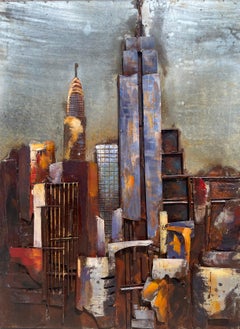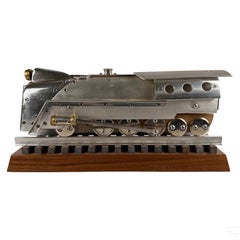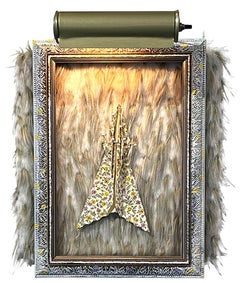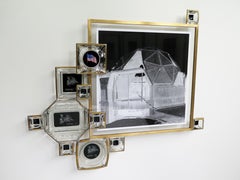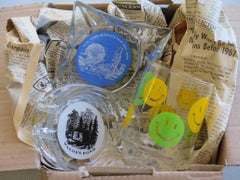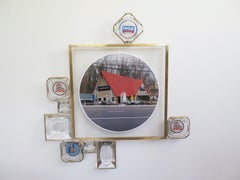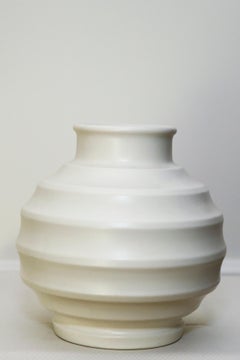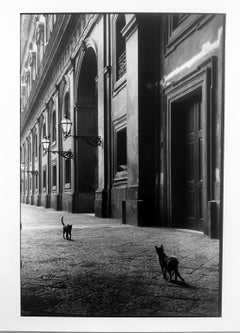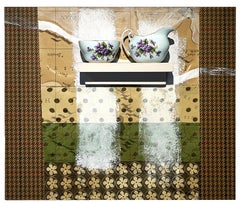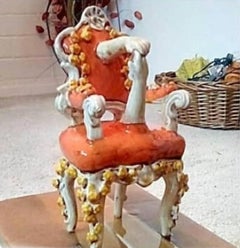Assemblage Still-life Sculptures
to
1
5
8
2
3
3
Overall Width
to
Overall Height
to
2
19
1
1
1,106
168
148
70
18
16
13
7
7
5
4
1
4
3
2
2
2
2
2
2
1
1
1
1
1
1
1
1
1
1
1
1
14
13
11
8
8
4
1
14
1
Style: Assemblage
Folk Outsider Naive Art Metal NYC Cityscape Sculpture Wall Hanging Contemporary
Located in New York, NY
Folk Outsider Naive Art Metal NYC Cityscape Sculpture Wall Hanging Contemporary
"NYC Cityscape"
39 1/2 x 29 1/2 x 2 inches
Unsigned
Offered is an extraordinary hand crafted wall s...
Category
1990s Assemblage Still-life Sculptures
Materials
Metal
Train Engine Folk Outsider Art Deco Assemblage Found Objects Contemporary Statue
Located in New York, NY
Train Engine Folk Outsider Art Deco Assemblage Found Objects Contemporary Statue
Actual Dimensions: 8.75 X 19.75 X 5.75 inches
Michael Riley (Mike Riley) (American, born 1957). A model train engine statue in mixed media. Metal, wood, and other elements. An Art Deco Moderne style design produced from found objects, including garden hose fitting, sliding door track, trombone instrument counter weights, flute instrument...
Category
2010s Assemblage Still-life Sculptures
Materials
Steel, Stainless Steel
"Specimen", frame with electric picture light, faux fur, paper, pins, on board
Located in Toronto, Ontario
“Specimen“ is a mixed media piece by artist Heather Nicol, and measures 16x13x3“. Part of a body of work known as Salon, this particular assemblage is co...
Category
21st Century and Contemporary Assemblage Still-life Sculptures
Materials
Board, Synthetic, Paper, Lights, Pins, Wood
Richard Klein, Expo 67, 2017, Found and altered objects assemblage
Located in Darien, CT
In the mid 1990s Richard Klein started working with found glass objects, including bottles, drinking glasses, ashtrays, and eyeglasses. Initially, Klein rejected any object with commercial or advertising content, but in 2015 he became fascinated with the promotional content that was screen printed on ashtrays from the 1950s, 1960s and early 1970s. This period was before smoking was looked at as being primarily a negative habit, and iconic American businesses, including Howard Johnson’s, International House of Pancakes (iHop) and Holiday Inn, all produced promotional ashtrays printed with their graphic identity.
By the time Klein became interested in these objects, the businesses had either ceased to exist, or had changed their logos, and many of their signature buildings, which where examples of classic, “Pop” roadside architecture, has been torn down or repurposed. The artist wanted to connect the glass objects with the business’s sites that were still recognizable and spoke of their history, so he began researching where original buildings still stood.
Klein then embarked on a series of road trips to photograph these sites with the intention of combining the photographs with the promotional glass objects. This led him to as far south as Maryland and as far north as upstate New York from his home in Connecticut.
In the case of Holiday Inn, it wasn’t their buildings, but their iconic illuminated sign that appeared on ashtrays, so he sought out a standing example of the sign he could photograph.
As it turned out all had been removed years before from the hotels' properties and the only working example was indoors at the Henry Ford Museum in Dearborn, Michigan. He did, however, find out that there was one still standing, surprisingly, in Beruit, Lebanon. He found an image of it on the web and used it to make Holiday Inn (Beruit).
In 1973 Holiday Inn changed their tagline from “The Nations Innkeeper” to “The World’s Innkeeper” as they expanded overseas, including the Mideast. For the hotel chain it was bad timing: the disastrous Lebanese civil war began in 1975. In the war, the different Lebanese militias involved in the conflict, including the Nasserites, Christian Phalangists, and the Lebanese National Movement engaged in what came to be called “The Battle of the Hotels” where they each occupied a major high-rise hotel in central Beruit. The Phalangists commanded the Holiday Inn, which they used to fire with both light arms and heavier weapons at the militias in neighboring hotels.
Klein used the photo of the heavily damaged Holiday Inn sign as I thought it spoke in a curious, offhanded way about American cultural imperialism in juxtaposition with an ashtray that proclaimed Holiday Inn to be “The World’s Innkeeper.” In the work Holiday Inn (Nocturne) the artist utilized a found, 35mm slide of a Holiday Inn sign at night at an unknown location as the basis of the photograph in the work.
Richard Klein is a Connecticut-based artist, independent curator and writer. As an artist, he has exhibited widely, including the Neuberger Museum of Art at SUNY Purchase; Caren Golden Fine Art, New York; the John Michael Kohler Arts Center, Sheboygan, WI; Hales Gallery, London; Gavlak Gallery, Palm Beach, FL; deCordova Sculpture Park and Museum, Lincoln, MA; James Barron Art, Kent, CT; The Portland Institute of Contemporary Art (PICA), Portland, OR; Schoolhouse Gallery, Provincetown, MA; Stephan Stoyanov Gallery, NY; Katonah Museum of Art, Katonah, NY; Brattleboro Museum and Art Center, Brattleboro, VT; Ortega y Gasset Projects, Brooklyn, NY; Exhibit by Alberson Tulsa, OK; Incident Report/Flow Chart Foundation, Hudson, NY; ICEHOUSE Project Space, Sharon, CT; Kenise Barnes Fine Art in Kent, CT and with ODETTA Gallery at the Equity Gallery in New York City..
Reviews of his work have appeared in Two Coats of Paint, Whitehot Magazine, The New York Times, Sculpture Magazine, Art in America, and The New Yorker. In the summer of 2024 he will be the first Artist-In-Residence at Peck Ledge Light...
Category
2010s Assemblage Still-life Sculptures
Materials
Metal
Richard Klein, American Glassware, 2010-2024, Found and altered objects
Located in Darien, CT
In the mid 1990s Richard Klein started working with found glass objects, including bottles, drinking glasses, ashtrays, and eyeglasses. Initially, Klein rejected any object with commercial or advertising content, but in 2015 he became fascinated with the promotional content that was screen printed on ashtrays from the 1950s, 1960s and early 1970s. This period was before smoking was looked at as being primarily a negative habit, and iconic American businesses, including Howard Johnson’s, International House of Pancakes (iHop) and Holiday Inn, all produced promotional ashtrays printed with their graphic identity.
By the time Klein became interested in these objects, the businesses had either ceased to exist, or had changed their logos, and many of their signature buildings, which where examples of classic, “Pop” roadside architecture, has been torn down or repurposed. The artist wanted to connect the glass objects with the business’s sites that were still recognizable and spoke of their history, so he began researching where original buildings still stood.
Klein then embarked on a series of road trips to photograph these sites with the intention of combining the photographs with the promotional glass objects. This led him to as far south as Maryland and as far north as upstate New York from his home in Connecticut.
American Glassware (2010-present) which is presented in a small, wall-mounted vitrine. American Glassware is composed of three glass objects: a “souvenir” Walden Pond ashtray made by me as a multiple; a real souvenir ashtray from the 1964-65 New York World’s Fair; and an authentic “Happy Face” drinking glass from the same era. They are all nestled in crumpled, vintage newspaper from 1967, and are presented together in a dilapidated cardboard box, as if they have been found in someone’s attic or basement. Once again, in a similar manner to the Glass House Ashtray, versions of his Walden Pond ashtray (Walden Pond Souvenir) have been injected into the collectable stream of tag sales and flea markets, creating a souvenir that never existed. The ashtray is screenprinted with an image of Thoreau’s cabin on Walden Pond as pictured on the title page of his book Walden, or Life in the Woods (1854). (The original illustration was created by Thoreau’s sister, Sophia.) Walden Pond Souvenir was originally produced for the 2010 exhibition Renovating Walden at the Tufts University Art Gallery in Medford, MA.
Richard Klein is a Connecticut-based artist, independent curator and writer. As an artist, he has exhibited widely, including the Neuberger Museum of Art at SUNY Purchase; Caren Golden Fine Art, New York; the John Michael Kohler Arts Center, Sheboygan, WI; Hales Gallery, London; Gavlak Gallery, Palm Beach, FL; deCordova Sculpture Park and Museum, Lincoln, MA; James Barron Art, Kent, CT; The Portland Institute of Contemporary Art (PICA), Portland, OR; Schoolhouse Gallery, Provincetown, MA; Stephan Stoyanov Gallery, NY; Katonah Museum of Art, Katonah, NY; Brattleboro Museum and Art Center, Brattleboro, VT; Ortega y Gasset Projects, Brooklyn, NY; Exhibit by Alberson Tulsa, OK; Incident Report/Flow Chart Foundation, Hudson, NY; ICEHOUSE Project Space, Sharon, CT; Kenise Barnes Fine Art in Kent, CT and with ODETTA Gallery at the Equity Gallery in New York City..
Reviews of his work have appeared in Two Coats of Paint, Whitehot Magazine, The New York Times, Sculpture Magazine, Art in America, and The New Yorker. In the summer of 2024 he will be the first Artist-In-Residence at Peck Ledge Light...
Category
2010s Assemblage Still-life Sculptures
Materials
Metal
Richard Klein, iHop II, 2018, Found and altered objects assemblage
Located in Darien, CT
In the mid 1990s Richard Klein started working with found glass objects, including bottles, drinking glasses, ashtrays, and eyeglasses. Initially, Klein rejected any object with commercial or advertising content, but in 2015 he became fascinated with the promotional content that was screen printed on ashtrays from the 1950s, 1960s and early 1970s. This period was before smoking was looked at as being primarily a negative habit, and iconic American businesses, including Howard Johnson’s, International House of Pancakes (iHop) and Holiday Inn, all produced promotional ashtrays printed with their graphic identity.
By the time Klein became interested in these objects, the businesses had either ceased to exist, or had changed their logos, and many of their signature buildings, which where examples of classic, “Pop” roadside architecture, has been torn down or repurposed. The artist wanted to connect the glass objects with the business’s sites that were still recognizable and spoke of their history, so he began researching where original buildings still stood.
Klein then embarked on a series of road trips to photograph these sites with the intention of combining the photographs with the promotional glass objects. This led him to as far south as Maryland and as far north as upstate New York from his home in Connecticut.
In the case of Holiday Inn, it wasn’t their buildings, but their iconic illuminated sign that appeared on ashtrays, so he sought out a standing example of the sign he could photograph.
As it turned out all had been removed years before from the hotels' properties and the only working example was indoors at the Henry Ford Museum in Dearborn, Michigan. He did, however, find out that there was one still standing, surprisingly, in Beruit, Lebanon. He found an image of it on the web and used it to make Holiday Inn (Beruit).
In 1973 Holiday Inn changed their tagline from “The Nations Innkeeper” to “The World’s Innkeeper” as they expanded overseas, including the Mideast. For the hotel chain it was bad timing: the disastrous Lebanese civil war began in 1975. In the war, the different Lebanese militias involved in the conflict, including the Nasserites, Christian Phalangists, and the Lebanese National Movement engaged in what came to be called “The Battle of the Hotels” where they each occupied a major high-rise hotel in central Beruit. The Phalangists commanded the Holiday Inn, which they used to fire with both light arms and heavier weapons at the militias in neighboring hotels.
Klein used the photo of the heavily damaged Holiday Inn sign as I thought it spoke in a curious, offhanded way about American cultural imperialism in juxtaposition with an ashtray that proclaimed Holiday Inn to be “The World’s Innkeeper.” In the work Holiday Inn (Nocturne) the artist utilized a found, 35mm slide of a Holiday Inn sign at night at an unknown location as the basis of the photograph in the work.
Richard Klein is a Connecticut-based artist, independent curator and writer. As an artist, he has exhibited widely, including the Neuberger Museum of Art at SUNY Purchase; Caren Golden Fine Art, New York; the John Michael Kohler Arts Center, Sheboygan, WI; Hales Gallery, London; Gavlak Gallery, Palm Beach, FL; deCordova Sculpture Park and Museum, Lincoln, MA; James Barron Art, Kent, CT; The Portland Institute of Contemporary Art (PICA), Portland, OR; Schoolhouse Gallery, Provincetown, MA; Stephan Stoyanov Gallery, NY; Katonah Museum of Art, Katonah, NY; Brattleboro Museum and Art Center, Brattleboro, VT; Ortega y Gasset Projects, Brooklyn, NY; Exhibit by Alberson Tulsa, OK; Incident Report/Flow Chart Foundation, Hudson, NY; ICEHOUSE Project Space, Sharon, CT; Kenise Barnes Fine Art in Kent, CT and with ODETTA Gallery at the Equity Gallery in New York City..
Reviews of his work have appeared in Two Coats of Paint, Whitehot Magazine, The New York Times, Sculpture Magazine, Art in America, and The New Yorker. In the summer of 2024 he will be the first Artist-In-Residence at Peck Ledge Light...
Category
2010s Assemblage Still-life Sculptures
Materials
Metal
Richard Klein, Holiday Inn Beirut, 2017, Found and altered objects assemblage
Located in Darien, CT
In the mid 1990s Richard Klein started working with found glass objects, including bottles, drinking glasses, ashtrays, and eyeglasses. Initially, Klein rejected any object with commercial or advertising content, but in 2015 he became fascinated with the promotional content that was screen printed on ashtrays from the 1950s, 1960s and early 1970s. This period was before smoking was looked at as being primarily a negative habit, and iconic American businesses, including Howard Johnson’s, International House of Pancakes (iHop) and Holiday Inn, all produced promotional ashtrays printed with their graphic identity.
By the time Klein became interested in these objects, the businesses had either ceased to exist, or had changed their logos, and many of their signature buildings, which where examples of classic, “Pop” roadside architecture, has been torn down or repurposed. The artist wanted to connect the glass objects with the business’s sites that were still recognizable and spoke of their history, so he began researching where original buildings still stood.
Klein then embarked on a series of road trips to photograph these sites with the intention of combining the photographs with the promotional glass objects. This led him to as far south as Maryland and as far north as upstate New York from his home in Connecticut.
In the case of Holiday Inn, it wasn’t their buildings, but their iconic illuminated sign that appeared on ashtrays, so he sought out a standing example of the sign he could photograph.
As it turned out all had been removed years before from the hotels' properties and the only working example was indoors at the Henry Ford Museum in Dearborn, Michigan. He did, however, find out that there was one still standing, surprisingly, in Beruit, Lebanon. He found an image of it on the web and used it to make Holiday Inn (Beruit).
In 1973 Holiday Inn changed their tagline from “The Nations Innkeeper” to “The World’s Innkeeper” as they expanded overseas, including the Mideast. For the hotel chain it was bad timing: the disastrous Lebanese civil war began in 1975. In the war, the different Lebanese militias involved in the conflict, including the Nasserites, Christian Phalangists, and the Lebanese National Movement engaged in what came to be called “The Battle of the Hotels” where they each occupied a major high-rise hotel in central Beruit. The Phalangists commanded the Holiday Inn, which they used to fire with both light arms and heavier weapons at the militias in neighboring hotels.
Klein used the photo of the heavily damaged Holiday Inn sign as I thought it spoke in a curious, offhanded way about American cultural imperialism in juxtaposition with an ashtray that proclaimed Holiday Inn to be “The World’s Innkeeper.” In the work Holiday Inn (Nocturne) the artist utilized a found, 35mm slide of a Holiday Inn sign at night at an unknown location as the basis of the photograph in the work.
Richard Klein is a Connecticut-based artist, independent curator and writer. As an artist, he has exhibited widely, including the Neuberger Museum of Art at SUNY Purchase; Caren Golden Fine Art, New York; the John Michael Kohler Arts Center, Sheboygan, WI; Hales Gallery, London; Gavlak Gallery, Palm Beach, FL; deCordova Sculpture Park and Museum, Lincoln, MA; James Barron Art, Kent, CT; The Portland Institute of Contemporary Art (PICA), Portland, OR; Schoolhouse Gallery, Provincetown, MA; Stephan Stoyanov Gallery, NY; Katonah Museum of Art, Katonah, NY; Brattleboro Museum and Art Center, Brattleboro, VT; Ortega y Gasset Projects, Brooklyn, NY; Exhibit by Alberson Tulsa, OK; Incident Report/Flow Chart Foundation, Hudson, NY; ICEHOUSE Project Space, Sharon, CT; Kenise Barnes Fine Art in Kent, CT and with ODETTA Gallery at the Equity Gallery in New York City..
Reviews of his work have appeared in Two Coats of Paint, Whitehot Magazine, The New York Times, Sculpture Magazine, Art in America, and The New Yorker. In the summer of 2024 he will be the first Artist-In-Residence at Peck Ledge Light...
Category
2010s Assemblage Still-life Sculptures
Materials
Metal
Richard Klein, McDonalds (El Nino), 2024, Found and altered objects assemblage
Located in Darien, CT
In the mid 1990s Richard Klein started working with found glass objects, including bottles, drinking glasses, ashtrays, and eyeglasses. Initially, Klein rejected any object with commercial or advertising content, but in 2015 he became fascinated with the promotional content that was screen printed on ashtrays from the 1950s, 1960s and early 1970s. This period was before smoking was looked at as being primarily a negative habit, and iconic American businesses, including Howard Johnson’s, International House of Pancakes (iHop) and Holiday Inn, all produced promotional ashtrays printed with their graphic identity.
By the time Klein became interested in these objects, the businesses had either ceased to exist, or had changed their logos, and many of their signature buildings, which where examples of classic, “Pop” roadside architecture, has been torn down or repurposed. The artist wanted to connect the glass objects with the business’s sites that were still recognizable and spoke of their history, so he began researching where original buildings still stood.
Klein then embarked on a series of road trips to photograph these sites with the intention of combining the photographs with the promotional glass objects. This led him to as far south as Maryland and as far north as upstate New York from his home in Connecticut.
In the case of Holiday Inn, it wasn’t their buildings, but their iconic illuminated sign that appeared on ashtrays, so he sought out a standing example of the sign he could photograph.
As it turned out all had been removed years before from the hotels' properties and the only working example was indoors at the Henry Ford Museum in Dearborn, Michigan. He did, however, find out that there was one still standing, surprisingly, in Beruit, Lebanon. He found an image of it on the web and used it to make Holiday Inn (Beruit).
In 1973 Holiday Inn changed their tagline from “The Nations Innkeeper” to “The World’s Innkeeper” as they expanded overseas, including the Mideast. For the hotel chain it was bad timing: the disastrous Lebanese civil war began in 1975. In the war, the different Lebanese militias involved in the conflict, including the Nasserites, Christian Phalangists, and the Lebanese National Movement engaged in what came to be called “The Battle of the Hotels” where they each occupied a major high-rise hotel in central Beruit. The Phalangists commanded the Holiday Inn, which they used to fire with both light arms and heavier weapons at the militias in neighboring hotels.
Klein used the photo of the heavily damaged Holiday Inn sign as I thought it spoke in a curious, offhanded way about American cultural imperialism in juxtaposition with an ashtray that proclaimed Holiday Inn to be “The World’s Innkeeper.” In the work Holiday Inn (Nocturne) the artist utilized a found, 35mm slide of a Holiday Inn sign at night at an unknown location as the basis of the photograph in the work.
Richard Klein is a Connecticut-based artist, independent curator and writer. As an artist, he has exhibited widely, including the Neuberger Museum of Art at SUNY Purchase; Caren Golden Fine Art, New York; the John Michael Kohler Arts Center, Sheboygan, WI; Hales Gallery, London; Gavlak Gallery, Palm Beach, FL; deCordova Sculpture Park and Museum, Lincoln, MA; James Barron Art, Kent, CT; The Portland Institute of Contemporary Art (PICA), Portland, OR; Schoolhouse Gallery, Provincetown, MA; Stephan Stoyanov Gallery, NY; Katonah Museum of Art, Katonah, NY; Brattleboro Museum and Art Center, Brattleboro, VT; Ortega y Gasset Projects, Brooklyn, NY; Exhibit by Alberson Tulsa, OK; Incident Report/Flow Chart Foundation, Hudson, NY; ICEHOUSE Project Space, Sharon, CT; Kenise Barnes Fine Art in Kent, CT and with ODETTA Gallery at the Equity Gallery in New York City..
Reviews of his work have appeared in Two Coats of Paint, Whitehot Magazine, The New York Times, Sculpture Magazine, Art in America, and The New Yorker. In the summer of 2024 he will be the first Artist-In-Residence at Peck Ledge Light...
Category
2010s Assemblage Still-life Sculptures
Materials
Metal
Lisa Levy, Didn't Have to Buy It, Mirror, Plastic, Marble, Found Objects
By Lisa Levy
Located in Darien, CT
Dr. Lisa's Ego Championship Trophies
Lisa Levy is a painter, conceptual artist, comedian and (self-proclaimed) psychotherapist.
Lisa's visual career started when she was 3 1/2 ...
Category
21st Century and Contemporary Assemblage Still-life Sculptures
Materials
Marble
Lisa Levy, Shut Up You Look Great, 2014, Mirror, Plastic, Marble, Found Objects
By Lisa Levy
Located in Darien, CT
Dr. Lisa's Ego Championship Trophies
Lisa Levy is a painter, conceptual artist, comedian and (self-proclaimed) psychotherapist.
Lisa's visual career started when she was 3 1/2 ...
Category
21st Century and Contemporary Assemblage Still-life Sculptures
Materials
Marble
"Cordial", wallpaper, spray paint, aunt's pearls, crystal, red resin, on board
Located in Toronto, Ontario
“Cordial“ is a wall relief panel by artist Heather Nicol, and measures 16x19x4“. Part of a body of work known as Brief Lives, this particular piece is comprised of wallpaper, spray paint, wood, the artist's aunt's pearls, crystal and red resin (solid), mounted on board. It fixes to the wall with a custom-fit wooden cleat. Reflecting on domestic materials and their relationships to display and social identity, Cordial celebrates and questions feminist reclamation, nostalgic tenderness and the histories embedded in the objects, while carrying on their aesthetic traditions through transformation into works of art.
Heather Nicol is a multidisciplinary artist whose practice includes immersive sound installation, small-scale discrete object making, and independent curating. Her large site-specific interventions explore the architectural, sonic, historic and operational conditions across a wide range of locations. These include concourse atriums, rail terminus, lobbies, a theatre, a public school building, a theme...
Category
21st Century and Contemporary Assemblage Still-life Sculptures
Materials
Glass, Wood, Found Objects, Board, Resin, Spray Paint
Lisa Levy, You Give Good Gratitude, 2014, Mirror, Plastic, Marble, Found Objects
By Lisa Levy
Located in Darien, CT
Dr. Lisa's Ego Championship Trophies
Lisa Levy is a painter, conceptual artist, comedian and (self-proclaimed) psychotherapist.
Lisa's visual career started when she was 3 1/2 ...
Category
21st Century and Contemporary Assemblage Still-life Sculptures
Materials
Marble
Lisa Levy, You See Through Bullshit, 2014, Mirror, Plastic, Marble, Found Object
By Lisa Levy
Located in Darien, CT
Dr. Lisa's Ego Championship Trophies
Lisa Levy is a painter, conceptual artist, comedian and (self-proclaimed) psychotherapist.
Lisa's visual career started when she was 3 1/2 ...
Category
21st Century and Contemporary Assemblage Still-life Sculptures
Materials
Marble
"Fox Hunt", wallpaper, acrylic paint, optical lens, screws, mounted on board
Located in Toronto, Ontario
“Fox Hunt“ is a wall relief panel by artist Heather Nicol, and measures 16x19x4“. Part of a body of work known as Brief Lives, this particular piece is comprised of wallpaper, wood, acrylic paint, screws and an optical lens...
Category
21st Century and Contemporary Assemblage Still-life Sculptures
Materials
Glass, Wood, Found Objects, Board, Acrylic
"Salon 13" is a collection of 13 small mixed media pieces with electric lighting
Located in Toronto, Ontario
“Salon (13)“ is a collection of 13 small-scale works by artist Heather Nicol. The installation of 13 assemblages is variable. The artist will personally consult with the buyer and can be on site for the installation. The 13 mixed media pieces include delicate lighting elements that shift and change via arduino electronic devices, or utilize picture lights throwing a soft roll of light across the artwork. These works are linked through their wiring, which is enveloped in a white umbilical cord-like fabric casing, creating an organic, unifying code of display.
Heather Nicol is a multidisciplinary artist whose practice includes immersive sound installation, small-scale discrete object making, and independent curating. Her large site-specific interventions explore the architectural, sonic, historic and operational conditions across a wide range of locations. These include concourse atriums, rail terminus, lobbies, a theatre, a public school building, a theme park...
Category
21st Century and Contemporary Assemblage Still-life Sculptures
Materials
Metal, Wire
"Parlour", wallpaper, glass, silver platter, butterfly, nails, mounted on board
Located in Toronto, Ontario
“Parlour“ is a wall relief panel by artist Heather Nicol, and measures 17x19x4“. Part of a body of work known as Brief Lives, this particular piece is comprised of wallpaper, fabric, wood, nails, glass, silver platter, plastic wrap, butterfly specimen, mounted on board. It fixes to the wall with a custom-fit wooden cleat. Reflecting on domestic materials and their relationships to display and social identity, Parlour celebrates and questions feminist reclamation, nostalgic tenderness and the histories embedded in the objects, while carrying on their aesthetic traditions through transformation into works of art.
Heather Nicol is a multidisciplinary artist whose practice includes immersive sound installation, small-scale discrete object making, and independent curating. Her large site-specific interventions explore the architectural, sonic, historic and operational conditions across a wide range of locations. These include concourse atriums, rail terminus, lobbies, a theatre, a public school building, a theme...
Category
21st Century and Contemporary Assemblage Still-life Sculptures
Materials
Silver
"Specimen 2", ornate frame, fur, LED light, paper, plastic bubble, trimming
Located in Toronto, Ontario
“Specimen 2“ is a mixed media piece by artist Heather Nicol, and measures 16x13x1“. Part of a body of work known as Salon, this particular assemblage is ...
Category
21st Century and Contemporary Assemblage Still-life Sculptures
Materials
Wood, Paper, Board, Fabric, Organic Material, Plastic, LED Light
"Kryptonite Wares", Found Objects 2015/2019, Chartreuse & Red, House Paint
Located in Detroit, MI
"Kryptonite Wares" is a clever and humorous collection of both superfluous and everyday objects purchased from the Dollar Store. It is a wry comment by the artist on the overabundanc...
Category
2010s Assemblage Still-life Sculptures
Materials
Plastic, Wood, Found Objects, Lights, Mixed Media, House Paint
"Guitar" figuratif music mechanism parts assembled 95x34x13 métal rock 2020
Located in Saint Pol de Léon, Bretagne
figuratif sculptures "Guitar"mechanism parts assembled 95x34x13 métal rock music
Jean-Pierre Bagnols is an artist who likes to take pieces of objects and give them a second life
here he used parts from a motorcycle to create a 70’s...
Category
2010s Assemblage Still-life Sculptures
Materials
Metal, Brass
$1,436 Sale Price
20% Off
Richard Klein, Holiday Inn Nocturne, 2020, Found and altered objects assemblage
Located in Darien, CT
In the mid 1990s Richard Klein started working with found glass objects, including bottles, drinking glasses, ashtrays, and eyeglasses. Initially, Klein rejected any object with commercial or advertising content, but in 2015 he became fascinated with the promotional content that was screen printed on ashtrays from the 1950s, 1960s and early 1970s. This period was before smoking was looked at as being primarily a negative habit, and iconic American businesses, including Howard Johnson’s, International House of Pancakes (iHop) and Holiday Inn, all produced promotional ashtrays printed with their graphic identity.
By the time Klein became interested in these objects, the businesses had either ceased to exist, or had changed their logos, and many of their signature buildings, which where examples of classic, “Pop” roadside architecture, has been torn down or repurposed. The artist wanted to connect the glass objects with the business’s sites that were still recognizable and spoke of their history, so he began researching where original buildings still stood.
Klein then embarked on a series of road trips to photograph these sites with the intention of combining the photographs with the promotional glass objects. This led him to as far south as Maryland and as far north as upstate New York from his home in Connecticut.
In the case of Holiday Inn, it wasn’t their buildings, but their iconic illuminated sign that appeared on ashtrays, so he sought out a standing example of the sign he could photograph.
As it turned out all had been removed years before from the hotels' properties and the only working example was indoors at the Henry Ford Museum in Dearborn, Michigan. He did, however, find out that there was one still standing, surprisingly, in Beruit, Lebanon. He found an image of it on the web and used it to make Holiday Inn (Beruit).
In 1973 Holiday Inn changed their tagline from “The Nations Innkeeper” to “The World’s Innkeeper” as they expanded overseas, including the Mideast. For the hotel chain it was bad timing: the disastrous Lebanese civil war began in 1975. In the war, the different Lebanese militias involved in the conflict, including the Nasserites, Christian Phalangists, and the Lebanese National Movement engaged in what came to be called “The Battle of the Hotels” where they each occupied a major high-rise hotel in central Beruit. The Phalangists commanded the Holiday Inn, which they used to fire with both light arms and heavier weapons at the militias in neighboring hotels.
Klein used the photo of the heavily damaged Holiday Inn sign as I thought it spoke in a curious, offhanded way about American cultural imperialism in juxtaposition with an ashtray that proclaimed Holiday Inn to be “The World’s Innkeeper.” In the work Holiday Inn (Nocturne) the artist utilized a found, 35mm slide of a Holiday Inn sign at night at an unknown location as the basis of the photograph in the work.
Richard Klein is a Connecticut-based artist, independent curator and writer. As an artist, he has exhibited widely, including the Neuberger Museum of Art at SUNY Purchase; Caren Golden Fine Art, New York; the John Michael Kohler Arts Center, Sheboygan, WI; Hales Gallery, London; Gavlak Gallery, Palm Beach, FL; deCordova Sculpture Park and Museum, Lincoln, MA; James Barron Art, Kent, CT; The Portland Institute of Contemporary Art (PICA), Portland, OR; Schoolhouse Gallery, Provincetown, MA; Stephan Stoyanov Gallery, NY; Katonah Museum of Art, Katonah, NY; Brattleboro Museum and Art Center, Brattleboro, VT; Ortega y Gasset Projects, Brooklyn, NY; Exhibit by Alberson Tulsa, OK; Incident Report/Flow Chart Foundation, Hudson, NY; ICEHOUSE Project Space, Sharon, CT; Kenise Barnes Fine Art in Kent, CT and with ODETTA Gallery at the Equity Gallery in New York City..
Reviews of his work have appeared in Two Coats of Paint, Whitehot Magazine, The New York Times, Sculpture Magazine, Art in America, and The New Yorker. In the summer of 2024 he will be the first Artist-In-Residence at Peck Ledge Light...
Category
2010s Assemblage Still-life Sculptures
Materials
Metal
STUDIO FETICH
Located in New York, NY
mixed media collage (ink, found objects, acrylic) in acrylic box. Edition 20/75
Category
1960s Assemblage Still-life Sculptures
Materials
Acrylic Polymer, Mixed Media
Related Items
Keith Murray "Bombe" Vases in Moonstone (other colors available)
Located in Brookville, NY
Keith Murray, architect and industrial designer, created this particular vase, "Chinese Lantern" in moonstone white ( shape no.3765) Made in England. Priced individually at $1200 each, we have this same vase in Yellow and in Green. A quote can be given for additional pieces. We have yellow green and moonstone in bombe in small and large sizes. We have celadon bowls, yellow bowls, and small moonstone pot with lid. All c. 1935 art deco style made in England. All in excellent condition.
These are the most desirable classic examples of pottery by Architect Keith Murray produced for Wedgwood in the 1930's.
Published and illustrated in the book "Wedgwood Ceramics...
Category
1930s Assemblage Still-life Sculptures
Materials
Clay
$1,200
H 7.5 in W 7 in
Naples, Italy, Cats, Black and White Street Photography 1950s
Located in New york, NY
American Photographer Leonard Freed travelled extensively and enjoyed Italy - a country he returned to often and photographed throughout his long photographic career. Cats, Naples, I...
Category
1950s Assemblage Still-life Sculptures
Materials
Film, Photographic Film, Silver Gelatin
$1,900
H 10 in W 8 in
Antique, 19th C. Peugeot Frères Brevetés French Coffee Grinder Table Sculpture
Located in Surfside, FL
This is being sold as a piece of (functional?) decorator table sculpture for a kitchen or restaurant. I do not know if or how it works. the wheel and gears turn. It might be missing a cover on the handle. It is a lovely antique piece. Made in France.
A halfcentury before they produced their first car, the Peugeot brothers were making coffee grinders, continuing to do so for over 100years. In 1840 the Peugeots produced their first moulin a
cafe out of a combination of metal and wood. The beans were inserted into the metal
hopper up top; metal gears were turned by a woodenknob-capped metal...
Category
Late 19th Century Assemblage Still-life Sculptures
Materials
Metal, Brass
$850
H 14.5 in W 14 in D 8.5 in
Rue de Rivoli, Paris, France (Collage, Cityscape, Iconic, ~36% OFF)
Located in Kansas City, MO
Gottfried Salzmann
Rue de Rivoli, Paris, France (Collage, Cityscape, Iconic)
Screen Print over Photograph
Year: Circa 2010
Size: 11.22 × 7.87 inches (28.5 x 20 cm)
Edition: 50
Signed...
Category
2010s Assemblage Still-life Sculptures
Materials
Photographic Paper, Screen
$255 Sale Price
36% Off
H 11.22 in W 7.87 in
Robert Mapplethorpe, Pair of Porcelain Plates
Located in Long Island City, NY
A pair of limited edition ceramic plates incorporating Robert Mapplethorpe’s Cala Lily and Poppy Flower photographic images. This set is new, ...
Category
Early 2000s Assemblage Still-life Sculptures
Materials
Porcelain
Arrival, Shipyards tales. Iron vessel wall sculpture. 49x42"
Located in Tel Aviv, IL
Nir Adoni's metal vessels sculptures have become his signature art and are displayed in public buildings around the world.
We are offering limited editions ...
Category
2010s Assemblage Still-life Sculptures
Materials
Metal, Steel, Iron
$6,500
H 49 in W 42 in D 2 in
Modernist Cubist Sculpture by Bill Low with Weathered Bronze Finish
By Bill Low
Located in Hudson, NY
Cubist abstract mixed-media sculpture titled 'Horse and Rider' was created using various materials including wood, papier-mache, and paint by Bill Low (Scotl...
Category
Mid-20th Century Assemblage Still-life Sculptures
Materials
Wood, Paint, Paper
$1,600
H 17.13 in W 14 in D 6 in
Pair Japanese Lacquered Maki-e Meiji Period Cabinets 漆器 蒔絵 塗物 漆塗
Located in Cotignac, FR
A pair of Meiji period, late 19th Century Lacquerware (漆器, shikki) miniature cabinets on stands. The decorative panels are of very fine quality. The cabinets are a 'true pair' that i...
Category
Late 19th Century Assemblage Still-life Sculptures
Materials
Wood, Lacquer
Robert Mapplethorpe, Poppy Flower Porcelain Plate
Located in Long Island City, NY
Artist: after Robert Mapplethorpe, American (1946 - 1989)
Title: Calla Lily
Date: circa 2000
Medium: Porcelain Plate, printed signature verso
Edition Size: 500
Diameter: 8.25 inches
...
Category
Early 2000s Assemblage Still-life Sculptures
Materials
Porcelain
Thumbprint (Red), original three dimensional geometric design wall relief
By Chuck Krause
Located in Fairfield, CT
Artist: Chuck Krause (1949)
Title: Thumbprint (Red)
Year: 2020
Medium: Acrylic paint on sculpted composite board
Size: 23 x 18 inches
Condition: Excellent
Inscription: Signed by the ...
Category
2010s Assemblage Still-life Sculptures
Materials
Acrylic Polymer, Board
$680 Sale Price
20% Off
H 23 in W 18 in D 0.5 in
Curtis Jere Copper Toned Metal Tree Sculpture c.1970s
By Curtis Jeré
Located in San Francisco, CA
Curtis Jere Copper Toned Metal Tree Sculpture c.1970s
Tall and elegant tree sculpture by listed American artist Curtis Jere.
The tree is made from...
Category
Mid-20th Century Assemblage Still-life Sculptures
Materials
Metal
$1,850 Sale Price
32% Off
H 73 in W 31 in D 5 in
Robert Mapplethorpe, Calla Lily Porcelain Plate
Located in Long Island City, NY
Artist: after Robert Mapplethorpe, American (1946 - 1989)
Title: Calla Lily
Date: circa 2000
Medium: Porcelain Plate, printed signature verso
Edition Size: 500
Diameter: 8.25 inches
...
Category
Early 2000s Assemblage Still-life Sculptures
Materials
Porcelain
Previously Available Items
"Afternoon Tea", wallpaper, acrylic paint, found objects mounted on board
Located in Toronto, Ontario
“Afternoon Tea“ is a wall relief panel by artist Heather Nicol, and measures 16x19x4“. Part of a body of work known as Brief Lives, this particular piece...
Category
21st Century and Contemporary Assemblage Still-life Sculptures
Materials
Wood, Found Objects, Acrylic, Board
Orange Armchair
By Renee Tay
Located in Santa Monica, CA
Assemblage sculpture
Category
21st Century and Contemporary Assemblage Still-life Sculptures
Materials
Mixed Media
STUDIO FETICH
Located in New York, NY
mixed media collage (ink, found objects, acrylic) in acrylic box. Edition 20/75
Category
1960s Assemblage Still-life Sculptures
Materials
Acrylic Polymer, Mixed Media
MAGISCOPE Steel Glass Assemblage Sculpture Mexican Latin American Contemporary
By Feliciano Béjar
Located in New York, NY
Feliciano Bejar (Mexico, 1920- 2007) “Magiscope 20” assemblage sculpture, 8 ¾w x 18 ½h inches, signed and dated 2002 on glass lens, acquired from Galeria des Artistes, Pureto Vallert...
Category
Early 2000s Assemblage Still-life Sculptures
Materials
Steel
Assemblage still-life sculptures for sale on 1stDibs.
Find a wide variety of authentic Assemblage still-life sculptures available for sale on 1stDibs. Works in this style were very popular during the 21st Century and Contemporary, but contemporary artists have continued to produce works inspired by this movement. Many Pop art paintings were created by popular artists on 1stDibs, including Lisa Levy, Adnan Charara, Michael Kalish, and Mary Bauermeister. Frequently made by artists working with Wood, and Found Objects and other materials, all of these pieces for sale are unique and have attracted attention over the years. Not every interior allows for large Assemblage still-life sculptures, so small editions measuring 3.5 inches across are also available. Prices for still-life sculptures made by famous or emerging artists can differ depending on medium, time period and other attributes. On 1stDibs, the price for these items starts at $600 and tops out at $12,500, while the average work sells for $1,700.
